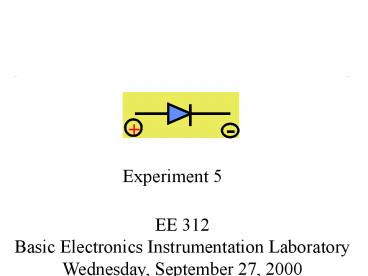Experiment 5 - PowerPoint PPT Presentation
Title:
Experiment 5
Description:
Title: No Slide Title Author: Kasra Etemadi Last modified by: James J. Whalen Created Date: 11/3/1995 5:43:20 PM Document presentation format: On-screen Show – PowerPoint PPT presentation
Number of Views:60
Avg rating:3.0/5.0
Title: Experiment 5
1
Experiment 5
EE 312 Basic Electronics Instrumentation
Laboratory Wednesday, September 27, 2000
2
Objectives
- Si Rectifier Forward I-V Characteristics
- Forward Conduction
- at Room Temp (T)
- at Elevated Temp (IVT Method)
- Characteristics of Zener Diodes
- Forward Conduction at Room Temp
- Reverse Conduction at Room Temp
3
Background
Two Types
Vacuum Tube Diode
4
Semiconductor Diodes
Anode
-
Anode
Cathode
I
Cathode
5
Types of diodes
6
VD
R
External Limit
VD
1/RD
Diode Piece-wise approximation
VT
7
Si
Ge
Tube
Forward current (mA)
Forward bias(V)
Reverse bias (V)
Reverse current (uA)
8
Parameters
- Maximum average forward current (IF,Max)
- Full-cycle average current IF that the diode can
safely conduct without becoming overheated - PRV, PIV,or VRM
- peak reverse voltage
- peak inverse voltage
- voltage reverse, maximum
- (Maximum allowable reverse-bias voltage for the
diode) - PRV rating of 200 V means that the diode may
breakdown conduct may even be destroyed, if
the peak reverse voltage is greater than 200 V
All mean the same
9
- Surge or fault current (ISurge)
- The amount of momentary overload current Isurge
the diode can withstand without being destroyed - Temperature Range
- Forward voltage drop (VF)
- VF across the diode when it is conducting, given
at the maximum average forward current - Maximum reverse current (IR,Max)
- Maximum current IR the diode can handle for
sustained period of time when operated as a Zener
Diode - Other Parameters
- Base diagram, total capacitance, reverse recovery
time, recommended operating ranges
10
(No Transcript)
11
Forward Characteristics
ID
I F
RdyndV/dI
RdVF/IF
VD
VF
Reverse Characteristics
12
Procedures
- 1- Silicon Rectifier (IVT)
- Forward I-V at 21 C
- Forward I-V at 45 C 70 C
- 2- Silicon Zener Diode (I-V)
- Forward I-V at 21 C
- Reverse I-V at 21 C
- 3- PSPICE Simulation (Bell 242)
13
Components
- Silicon Rectifer (VBD lt 200 V)
- Si Diode (Zener, VBD 27 V or 12 V)
- 0.1, 1.0, 4.7 kohms 2Watt Resistors
- Heater Block Tube Insulator
- Temperature Probe
- Variac (Shock Warning Not Isolated From Power
Line)
14
1- Forward Characteristics of Diodes
R
Vary R from 100 k to 100
15
Vdc
Rectifier Zener
R ohm
Vdc V
10.38 . . . 10.822
100k . . . 100
16
2-Reverse Characteristics of Zener Diode(at
voltages below breakdown)
4.7 k
DMM
I
?1k?
DMM
28V
V
0-40V
-
ID
VD
17
DC CONSTANT-VOLTAGE CURRENT-LIMITED FLOATING
POWER SUPPLY
-
18
2-Reverse Characteristics of Zener diode (at
breakdown region)
19
(No Transcript)
20
3- Simulation (PSPICE)
D1 2 0 Diode .Model Diode D(IS1E-14 RS5 N1
BV25 IBV1E-10) default Unit IS
Saturation current 1.0E-14 A RS Ohmic
resistance 0 Ohm N Emission
Coefficient 1 - BV Reverse breakdown
voltage infinite V IBV Current at breakdown
voltage 1.0E-3 A
ISR, NR, IKF, NBV, IBVL, NBVL, TT, CJO, VJ, M FC,
EG, XTI, TIKF, TBV1, TBV2, TRS1, TRS2, KF, AF
21
5- Temperature Characteristics of Ge Diode
Thermocouple Probe
Hot Block
Ceramic Tube
Heaters
Ge Diode
to Variac
5 cm
22
Temperature Probe
converter Box
Probe
23
Temperature Dependence of IS See Sedra/Smith,
TABLE 3-1, p. 156 Insert expression for the
intrinsic carrier concentration ni2 into the
expression for the the saturation current IS IS
C1 X T3 X exp(-EG/kT) where C1 is a
constant The T3 temperature dependence is
weak compared to the exponential temperature
dependence so that IS C2 X exp(-EG/kT)
where C2 C1 X 3003 lnIS ln(C1 X 3003 ) -
EG/kT
24
Temperature Dependence of IS See Sedra/Smith,
TABLE 3-1, p. 156 Insert expression for the
intrinsic carrier concentration ni2 into the
expression for the the saturation current IS IS
C1 X T3 X exp(-EG/kT) where C1 is a
constant The T3 temperature dependence is
weak compared to the exponential temperature
dependence so that IS C2 X exp(-EG/kT)
where C2 C1 X 3003 lnIS ln(C1 X 3003 ) -
EG/kT
25
Precautions
- Always turn off the Variac and set its dial to
zero when not using it. - At the start of the lab period, preheat the hot
block to 40C. When you get to part 5, insert the
diode into the block and allow a few minutes for
the temperature to stabilize. - Do not exceed a temperature of 75C in the hot
block. - Do not exceed the current rating for the diode
- Ge IF, Max 100 mA I R,Max 1.0 mA
- Si I F,Max 100 mA I R,Max 100 mA
26
Must Submit Electronic Version Using Command
submit ee312 E5ReportTuAM Paper Version Also
Required
27
Team Writing
- Abstract Report for Zener Diode reverse IV on
the 1999 web - Introduction to be provided or omitted
- One Partner does silicon rectifier IVT results
discussion for IS n - Must provide results in a computer file to
Partner in less than one week submit to EE 312
Staff using submit command.
28
- Other Partner uses information provided by
partner to determine EG. Also include discussion
and conclusions . Submit report electronically
within one week of receiving partners
contribution. Paper version also. - PSPICE Simulations Not Required.
- Late penalties are -10 points per day and the day
starts at 900 AM.































